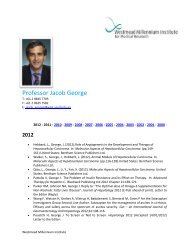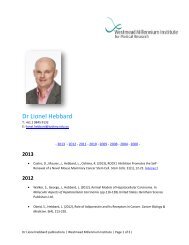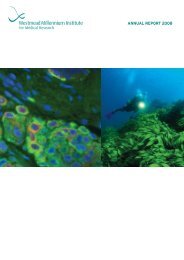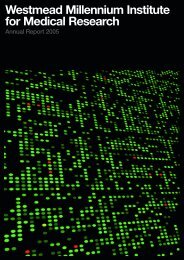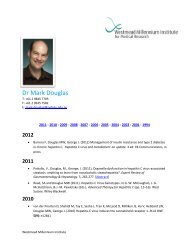Translating >> - Westmead Millennium Institute
Translating >> - Westmead Millennium Institute
Translating >> - Westmead Millennium Institute
- No tags were found...
You also want an ePaper? Increase the reach of your titles
YUMPU automatically turns print PDFs into web optimized ePapers that Google loves.
.<br />
< 30 31 > Research Report // AR 2006<br />
Infection and Immunity<br />
Centre for Infectious Diseases and Microbiology<br />
Fungal pathogenesis<br />
The group has shown that specialised lipid domains<br />
(“rafts”) in the cell membrane of the fungus Cryptococcus<br />
neoformans, which causes severe meningitis, serve as sites<br />
of attachment of a key enzyme, phospholipase B (PLB).<br />
This enzyme is attached to the raft by an anchor. When<br />
released from the anchor, free PLB1 facilitates penetration<br />
of Cryptococcus into lung and brain. We are now studying<br />
how the production and release of PLB1 is regulated and<br />
the mechanism by which it is released from the membrane.<br />
This fundamental knowledge will lead to new understanding<br />
of cryptococcal biology and help us to identify new<br />
target molecules for development of drugs to treat fungal<br />
infections. This work was received with great interest by the<br />
international cryptococcal research community.<br />
Antifungal drug development<br />
The group has an NHMRC project grant to make and test<br />
new chemical compounds that act on enzymes produced by<br />
fungi, which are important in virulence (and hence initiation<br />
of disease). Led by synthetic chemist, Dr Kate Jolliffe, 50<br />
novel compounds in 2 chemical classes have been made and<br />
tested against a range of fungi that cause disease in humans.<br />
Particular interesting is one class of compound related to<br />
a marketed drug, miltefosine, which was developed as an<br />
anti-cancer drug and is now used for treatment of a parasite<br />
infection (leishmaniasis). We will be undertaking further<br />
modification and testing of the most promising compounds<br />
in 2007.<br />
Bacterial pathogenesis, antibiotic resistance and<br />
novel diagnostics<br />
The group was the first to identify and have since<br />
characterised the genetic basis of newly arrived transmissible<br />
resistance to carbapenem antibiotics and the CTX-M<br />
type ESBLs newly arrived in Australia, including novel<br />
gene variants. The group has defined the basis for most<br />
major antibiotic resistance genes relevant in ICU in<br />
Australia, and begun to incorporate these into novel highspeed<br />
multiplexed assays in collaboration with industry<br />
partners. Assays developed for rapid detection of S. aureus,<br />
MRSA, and influenza (including H5N1 “bird flu”) are<br />
now entering clinical trials. Our work has been presented<br />
in major international conferences (eg ICAAC) and<br />
journals (eg Lancet Infections Diseases, Nature Reviews<br />
Microbiology). New areas include bacteriophage therapeutics<br />
(in collaboration with industry), novel immunofluorescence<br />
methods (funded by ARC, in collaboration with Macquarie<br />
University) and quorum-sensing inhibitors (funded by ARC,<br />
in collaboration with BioSignal/ UNSW).<br />
Nuclear magnetic resonance spectroscopy<br />
This has been a very successful year, with the completion of<br />
studies showing that biochemical profiles of different fungi<br />
can be identified by NMR spectroscopy and hence be of<br />
diagnostic value, and that resistance to medicines used in<br />
1<br />
NH 2<br />
1<br />
2<br />
2<br />
therapy can also be rapidly determined using this technology.<br />
The work has been published in the top international<br />
antibiotics journal and was presented at the leading<br />
international meeting on mycology (ISHAM), in Paris, in<br />
June 2006.<br />
Improved outcomes in immunosuppressed<br />
haematology patients<br />
This is a large Centre of Clinical Excellence Program now<br />
in its second year. So far research highlights have included<br />
a study of the occurrence, transmission and prevention of<br />
community respiratory virus infections in patients with<br />
cancer of the blood. Importantly the group has shown that<br />
protection of patients is improved by routine vaccination<br />
against influenza and education of patients, their carers,<br />
and staff about the importance of hand washing and other<br />
infection control measures. Several important ethics studies<br />
are underway, assessing patients understanding of informed<br />
consent for treatments that they receive, their response to<br />
living with cancer, and the effect of isolation during times of<br />
very low function of the immune system (in order to prevent<br />
serious infections). Other key programs are proceeding<br />
in vaccine research and the development of faster tests for<br />
diagnosis of infections, in order prevent, or to improve<br />
outcomes of serious infections through more rapid diagnosis<br />
and thus commencement of treatment.<br />
3<br />
6<br />
s<br />
s<br />
s<br />
10<br />
Centre for Transplant and Renal Research<br />
Pancreatic islet cell transplantation<br />
Following the units pioneering clinical trial of pancreatic islet<br />
transplantation they have been chosen to lead an Australia<br />
s<br />
11<br />
Peptide C<br />
wide consortium with the aim of developing pancreatic islet<br />
transplantation as a mainstream therapy for patients with<br />
difficult to control diabetes. The original trial involved six<br />
patients with severe metabolic complications from their<br />
diabetes. Five of the six had marked improved metabolic<br />
outcomes after successful pancreatic islet transplantation<br />
and three patients no longer required insulin injections for<br />
substantial periods of time. This trial identified progressive<br />
loss of islet graft function and complications from the<br />
anti-rejection drugs as the major impediments to it more<br />
widespread application. The new study, which has been<br />
funded by the Federal Government and the JDRF aims to<br />
identify factors that cause graft damage and to develop a safer<br />
immunosuppressive regimen.<br />
Pancreatic islet xenotransplantation research<br />
Currently pancreatic islet cell transplantation is the only<br />
known cure for Type 1 diabetes. If this therapy is to be<br />
more effective sources of insulin producing cells other than<br />
B<br />
A<br />
organ donors needs to be found. In collaboration with<br />
researchers in Melbourne and Adelaide we are investigating<br />
the use of pig pancreatic islet cells for future transplantation<br />
in human patients. The group’s current research is focused<br />
on understanding the mechanisms of early islet cell loss.<br />
This appears to be due to a combination of clotting and<br />
early cellular rejection. Our data suggests that producing<br />
pigs whose islet cells express several human proteins that<br />
regulate clotting and rejection may be sufficient to allow<br />
this tissue to be used safely in patients. This information<br />
has been used to develop a new line of pigs that have been<br />
genetically modified so that they may be better suited to<br />
clinical transplantation. Australia is the world leader in pig<br />
transgenesis and this ambitious collaborative project between<br />
four research institutes is making substantial progress in the<br />
development of pig islet cell xenotransplantation.<br />
Transplantation immunity and tolerance<br />
The aim of this group is to better understand the<br />
mechanisms of rejection of pancreatic islet xenografts<br />
and to develop novel strategies for suppressing this<br />
immune response. The group has made several findings in<br />
understanding the role macrophages play in the rejection<br />
of pig islet grafts. In particular they have shown that<br />
macrophages have a surprisingly specific and sophisticated<br />
recognition response for identifying pig tissue. At present<br />
work in this area is focusing on understanding the molecular<br />
mechanisms responsible for this recognition. In particular<br />
we have focused on a group of macrophage receptors called<br />
toll receptors and have found that they have an important<br />
role in regulating macrophage recognition of pig tissue.<br />
The group is also investigating novel strategies to induce<br />
tolerance to transplanted islet tissue and to further reduce<br />
the requirement for long-term immunosuppression. In<br />
particular they are focusing on the role of a regulatory T cell<br />
called CD4CD25+ T cells. They have found that these cells<br />
are capable of inducing tolerance to islet allografts and have<br />
begun investigating their role in maintaining tolerance to pig<br />
islet cells.<br />
Chronic allograft nephropathy research<br />
The aim of this group is to increase knowledge about the<br />
mechanisms for the long-term loss of renal transplant.<br />
Current treatment strategies are very good at preventing<br />
acute cellular rejection but over time renal transplants are<br />
s<br />
20<br />
s<br />
21<br />
still lost to a complex process known as Chronic Allograft<br />
Nephropathy. The group has been at the forefront of this<br />
research internationally and by studying protocol biopsies<br />
has identified several novel factors responsible for this<br />
chronic graft loss. The focus of the group is to understand<br />
the molecular mechanisms responsible for this loss<br />
using a genome wide analysis of biopsy specimens using<br />
genomics or gene chips. This had allowed us to identify<br />
early mechanisms of graft fibrosis and glomerulosclerosis.<br />
Which in turn has allowed us to understand better the<br />
early pathology that ultimately leads to chronic allograft<br />
nephropathy. Ultimately it will assist us to develop a<br />
diagnositic test that predicts those patients that will develop<br />
this condition and to design new treatments. In the last 6<br />
months we have been successful in obtaining funding from<br />
the National <strong>Institute</strong>s of Health in the US to take part in<br />
a large multicentre study that will identify the genomics of<br />
Chronic Allograft Nephropathy.<br />
COOH



